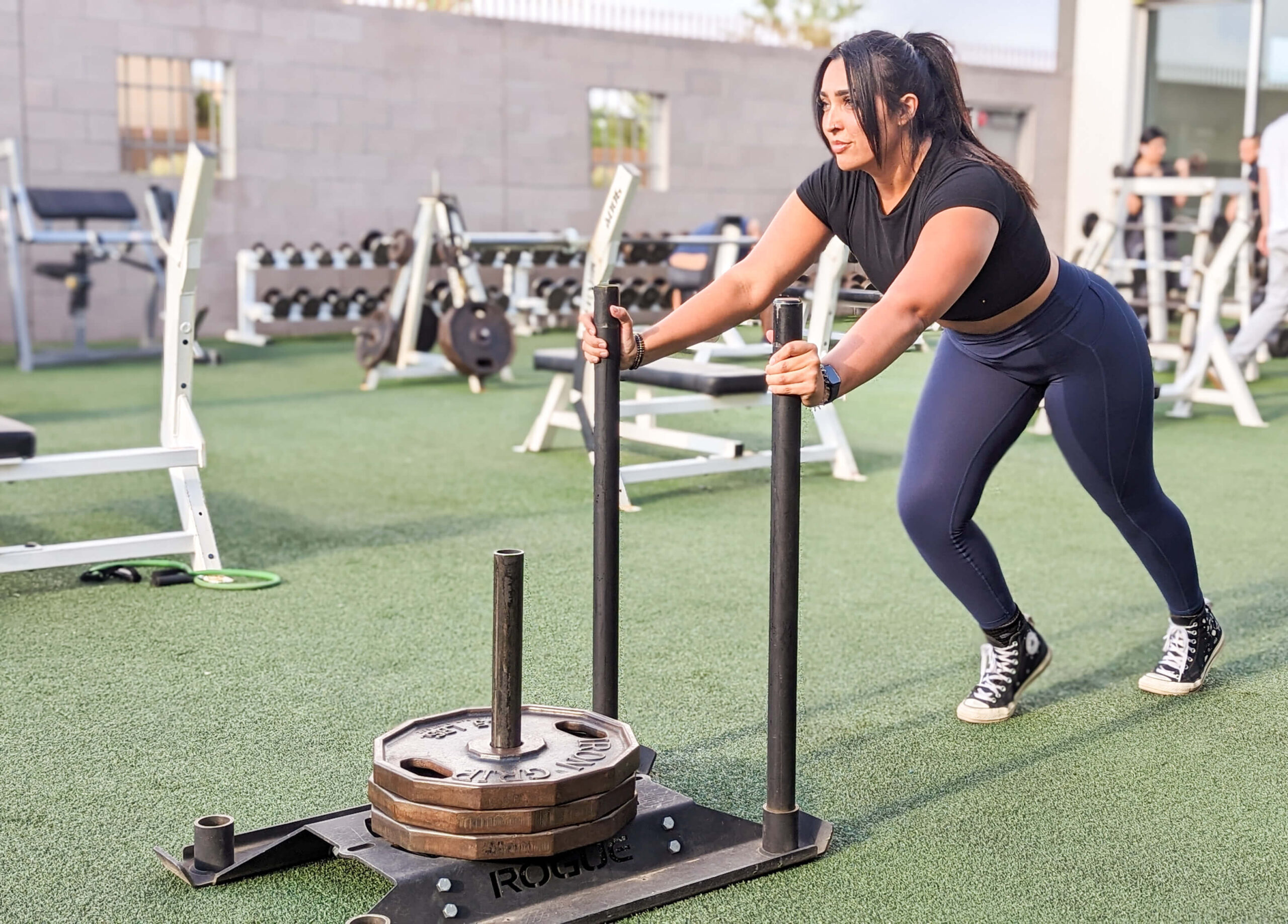When you’re just starting a strength training journey, it’s important to follow a few beginner strength trainer tips. By following a few tips and avoiding common weightlifting mistakes, you can protect your body from injuries, ensure you make consistent progress, and stay motivated. As you prepare to hit the gym and start lifting weights, take a moment to review the seven main strength training tips for beginners.
1. Realistic Expectations: Goal Setting for Success
Setting realistic goals will pave the path to achieving a stronger, more confident you. Instead of seeking immediate transformations, focus on enjoying the process and celebrate gradual improvements.
If you like following fitness influencers and models online, try not to compare your body to theirs. After all, they’ve likely been training for years while you’re just getting started, and you shouldn’t expect your body to match theirs after a few weeks of training.
Rather than comparing yourself to fitness influencers, acknowledge that everyone’s journey is unique, and your body will evolve at its own pace. Embracing a steady approach will encourage you to stick with a program, which is essential for long-lasting results as you become accustomed to specific movements and gradually increase your weight.
2. Know Your Lifting Limits for Safe, Consistent Progress
Knowing how to prevent lifting injuries starts with knowing your limits and remembering that you’re not competing against anyone other than yourself. When beginners lift too heavy, they’ll usually overcompensate with other parts of their body, making it harder for them to maintain proper form throughout the lift.
Rather than feeling pressured to lift heavy, prioritize mastering proper form and gradually increasing your weights. This approach will enhance your progress and minimize the risk of injury. Focusing on controlled, steady progress allows you to build a solid foundation and enjoy your workouts more fully.
How Much Weight Should a Beginner Lift?
When you’re starting out, begin with just your body weight to practice the movement pattern first. Focus on mastering good form so every rep looks and feels the same. Once you’re comfortable, increase the weight slowly in small jumps of about 2.5 to 5 pounds (1 to 2 kilograms).
If you are eager to start lifting weights, a great rule of thumb is the Talk Test: choose a weight you can lift 12 to 15 times with proper form while still being able to speak a short sentence. If you’re gasping for air by rep 8, it’s too heavy. If you could easily chat through 20 reps, it’s probably too light.
How Many Reps and Sets Should Beginners Do?
| Goal | Reps | Sets | Rest |
|---|---|---|---|
| General fitness / fat loss | 12–15 | 2–3 | 30–60 s |
| Strength focus | 8–10 | 3–4 | 60–90 s |
| Endurance / injury-proofing | 15–20 | 2 | 30 s |
3. Embrace Warm-Ups and Mobility Work
Another key component of weightlifting injury prevention is making sure you prioritize and embrace warming up. While it might seem like an extra step, warming up is essential for preparing your muscles and preventing injuries. Spending just a few minutes on a targeted warm-up can enhance your workout quality and improve your range of motion.
The best warm-up routine before lifting weights will usually take less than 10 minutes and be geared toward the specific muscles you’re planning on working out. For example, if you’re planning on doing dumbbell squats, you can do air squats to get used to the movement and warm those specific muscles up before you add weight. Avoid long static stretches during warm-ups, as some evidence suggests it could reduce your strength. Dynamic stretching and mobility work, however, are recommended, as they can improve your range of motion and assist your lift.
What Should My Warm-Up Look Like for Weight Lifting?
Spend 8–10 minutes warming up:
- 2–3 min cardio: brisk walk, rower, or jump rope
- 3 min mobility: arm circles, hip circles, leg swings
- 3–4 min movement prep: practice your first lift with bodyweight or light weight—for example, bodyweight squats before squatting or band pull-aparts before pressing.
4. Prioritize Rest and Recovery
When you start hitting your groove in the gym and begin looking forward to working out, it’s important to still prioritize your rest and recovery. For most people, it’s recommended to take one or two days off to rest, as it gives your muscles time to repair torn tissue and reduces the risk of injury. For gym warriors who want to stay active on rest days, do gentle active recovery workouts, such as yoga, swimming, stretching, or walking.
You’ll also want to listen to your body during your workouts. While a bit of strain tells you that you’re challenging your muscles, you shouldn’t actually be in pain. If something doesn’t feel right or you’re in constant pain while you lift, there’s a good chance you’ve injured yourself. Instead of trying to push through the pain, consult a doctor to ensure you stay healthy and injury-free. When you do have an injury, make sure to rest and let the injury fully heal.
5. Focus on Structure and Consistency
To maximize the benefits of strength training, try to maintain a consistent workout program rather than frequently switching between different classes or routines. Finding a plan that fits your goals and resonates with you can lead to more significant results, as you’ll effectively target specific muscle groups over time. Beginners who track their progress also tend to stay more motivated and committed, so keeping a workout notebook or entering your gains into an app can be a great way to keep yourself motivated to finish a program.
The same principle applies to individual workouts, as a workout plan can ensure your workouts stay focused on improving your target muscles. A plan can also make sure you have enough variety in your exercises, keeping your workouts fun while still focusing on the same muscle groups. For example, you might do concentration curls on one arm day and preacher curls on the next, as both target the short head of your biceps.
Whether you’re doing individual workouts or joining a class, try to stick to it for at least three months. If you’ve kept track of your results, you’ll be surprised by how much progress you’ve made when you compare your first day to your last!
How Often Should Beginners Strength Train Each Week?
- Goldilocks zone: Work out on 2–3 non-consecutive days (e.g., Mon-Wed-Fri).
- Why not daily? Muscles grow during rest. If you skip it, your progress will slow.
- Add active recovery: On “off” days, 20-minute walks, light yoga, or swimming keep blood flowing without accumulating fatigue.
How Long Should a Beginner Strength Workout Be?
For most beginners, a strength workout takes about 45 minutes from start to finish. Here's a simple breakdown:
| Segment | Time |
|---|---|
| Warm-up | 8–10 min |
| Main lifts (3–4 exercises) | 25–35 min |
| Accessory/core work | 5–10 min |
| Cool-down stretch | 5 min |
| Total | ≈ 45 min |
If you're short on time, skip accessory work first—but always keep your warm-up and main lifts for safety and progress.
6. Diversify Your Lifts Beyond the "Big 3"
When people talk about lifting heavy weights, your mind might only go to benching, squatting, and deadlifts. These “big 3” exercises are popular for a reason, as they can excel at improving your overall strength. However, a well-rounded routine that includes functional exercises is crucial for overall strength, balance, and flexibility.
For beginners, you’ll want to start with full-body workouts most of the time to ensure you’re getting all your muscles involved. You might alternate between lower-body and upper-body days while making sure you’re doing multiple exercises that target different body parts.
Sticking to a more well-rounded workout plan also helps you address weak points and improves your overall mobility. This added mobility can be a huge help as you age, as you’ll be keeping your body flexible and strong enough to do common movements like standing up, reaching above your head, or bending.
7. Remember That You’re Welcome at the Gym
Working out isn’t just a physical challenge. It’s also a mental one. It’s easy to feel out of place at the gym when you first start, but you should also remember that most people actually want to help newcomers get in shape! After all, everyone has to start somewhere, and the way you look or your current strength level shouldn’t hold you back.
Since feeling self-confident can raise the chance you go to the gym, you may want to start with group exercise classes or work with a personal trainer to build your confidence. Group exercise classes can be a great way to meet other gym goers, get more comfortable at your local gym, and receive encouragement. A personal trainer can also help you gain greater confidence by helping you reach your fitness goals, understand proper form for weightlifting, and get praised for your gains.
Train the Right Way at Defined Fitness in New Mexico
If you want to avoid common strength training mistakes and put these beginner tips into action, Defined Fitness has a fitness program for you. We have multiple small-group fitness classes and small-group training options that are great for beginners who want to learn the ropes of strength training in an encouraging environment. When you’d prefer to learn how to lift weights correctly in a more private setting, you’ll want to work with one of our personal trainers, who will teach you proper form, create a personalized exercise plan for you, and provide all the support you need to reach your goals.
Learn more about our fitness memberships in New Mexico today. If you have any questions, please contact us.




